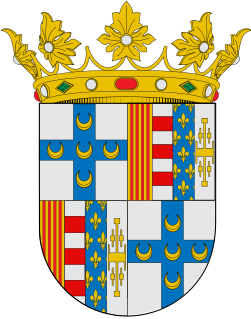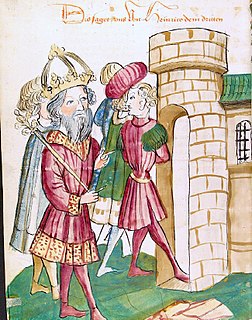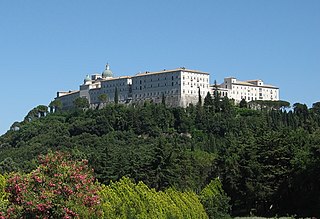
Guaimar IV was Prince of Salerno (1027–1052), Duke of Amalfi (1039–1052), Duke of Gaeta (1040–1041), and Prince of Capua (1038–1047) in Southern Italy over the period from 1027 to 1052. He was an important figure in the final phase of Byzantine authority in the Mezzogiorno and the commencement of Norman power. He was, according to Amatus of Montecassino, "more courageous than his father, more generous and more courteous; indeed he possessed all the qualities a layman should have—except that he took an excessive delight in women."

Pandulf I Ironhead was the Prince of Benevento and Capua from 943 until his death. He was made Duke of Spoleto and Camerino in 967 and succeeded as Prince of Salerno in 977 or 978. He was an important nobleman in the fight with the Byzantines and Saracens for control of the Mezzogiorno in the centuries after the collapse of Lombard and Carolingian authority on the Italian Peninsula. He established himself over almost the whole of the southern half of Italia before his death in March 981.

The Duchy of Gaeta was an early medieval state centered on the coastal South Italian city of Gaeta. It began in the early ninth century as the local community began to grow autonomous as Byzantine power lagged in the Mediterranean and the peninsula due to Lombard and Saracen incursions.

The Duchy of Naples began as a Byzantine province that was constituted in the seventh century, in the reduced coastal lands that the Lombards had not conquered during their invasion of Italy in the sixth century. It was governed by a military commander (dux), and rapidly became a de facto independent state, lasting more than five centuries during the Early and High Middle Ages. The modern city of Naples remains a significant region of Italy, today.
Guaimar III was the Lombard prince of Salerno from around 994 to his death. Under his reign, Salerno entered an era of great splendour. Opulenta Salernum was the inscription on his coins. He made Amalfi, Gaeta and Sorrento his vassals and annexed much of Byzantine Apulia and Calabria.

Sergius IV was Duke of Naples from 1002 to 1036. He was one of the prime catalysts in the growth of Norman power in the Mezzogiorno in the first half of the eleventh century. He was nominally a Byzantine vassal, like his father, John IV, before him.
Pandulf II the Old was the prince of Benevento from 981 and prince of Capua from 1008 or 1009 to his death, the son of Landulf III who was co-prince between 959 and 968. Pandulf was first associated as co-prince in 977.

Manso I was the duke of Amalfi (966–1004) and prince of Salerno (981–983). He was the son of Duke Sergius I and the greatest independent ruler of Amalfi, which he controlled for nearly half a century. He is sometimes numbered Manso III.
John V was the consul and duke of Gaeta from 1012 to 1032. He was the son of John IV and Sichelgaita, sister of Sergius IV of Naples. He was either very young when he succeeded his father or perhaps he was even born posthumously.

The Lombard Principality of Salerno was a South Italian state, formed in 851 out of the Principality of Benevento after a decade-long civil war.
The Principality of Capua was a Lombard state centred on Capua in Southern Italy, usually de facto independent, but under the varying suzerainty of Western and Eastern Roman Empires. It was originally a gastaldate, then a county, within the principality of Salerno.
John V was the son and successor of Sergius IV as Duke of Naples from 1034 until his death.
Atenulf I was the Lombard count of Aquino who rose to become Duke of Gaeta in Southern Italy during the chaotic middle of the eleventh century.
Maria of Gaeta was an Italian regent, countess of Aquino by marriage and regent of the Duchy of Gaeta for her son in 1062–65.
Marinus II was the Duke of Naples from 968 to his death. He was the son and successor of John III and brought Naples back into the Byzantine fold, receiving the title eminentissimus consul et dux, atque imperialis anthipatus patricius. In 970, Marinus did homage for his duchy to the Byzantine patrician Eugene after the imprisonment of Pandulf Ironhead. He then participated in the siege of Capua. He devastated the surrounding countryside and took an enormous booty before an army of Otto the Great forced the Greeks to retreat. In 974, Marinus allied with Manso I of Amalfi and Landulf of Conza to depose Gisulf I of Salerno. They were defeated, however, by the intervention of Pandulf Ironhead. On 4 November 981, the Emperor Otto II was in Naples, probably with the permission of Marinus, who was moving away from his pro-Byzantine policy. He died in 997 and was succeeded by his son Sergius III.

Paris is the capital and most populous city of France, with an area of 105 square kilometres and an official estimated population of 2,140,526 residents as of 1 January 2019. Since the 17th century, Paris has been one of Europe's major centres of finance, diplomacy, commerce, fashion, science, as well as the arts. The City of Paris is the centre and seat of government of the Île-de-France, or Paris Region, which has an estimated official 2019 population of 12,213,364, or about 18 percent of the population of France. The Paris Region had a GDP of €709 billion in 2017. According to the Economist Intelligence Unit Worldwide Cost of Living Survey in 2018, Paris was the second most expensive city in the world, after Singapore, and ahead of Zurich, Hong Kong, Oslo and Geneva. Another source ranked Paris as most expensive, on a par with Singapore and Hong Kong, in 2018. The city is a major railway, highway, and air-transport hub served by two international airports: Paris-Charles de Gaulle and Paris-Orly. Opened in 1900, the city's subway system, the Paris Métro, serves 5.23 million passengers daily, and is the second busiest metro system in Europe after Moscow Metro. Gare du Nord is the 24th busiest railway station in the world, but the first located outside Japan, with 262 million passengers in 2015.

John Julius Cooper, 2nd Viscount Norwich,, known as John Julius Norwich, was an English popular historian, travel writer and television personality.

London is the capital of and largest city in England and the United Kingdom, and the largest city in the European Union. Standing on the River Thames in the south-east of England, at the head of its 50-mile (80 km) estuary leading to the North Sea, London has been a major settlement for two millennia. Londinium was founded by the Romans. The City of London, London's ancient core − an area of just 1.12 square miles (2.9 km2) and colloquially known as the Square Mile − retains boundaries that follow closely its medieval limits. The City of Westminster is also an Inner London borough holding city status. Greater London is governed by the Mayor of London and the London Assembly.











